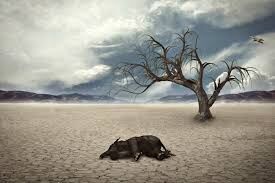
Attention
The Sixth Extinction?
Give us a bit of time, we'll get there.
Posted November 30, 2020 Reviewed by Lybi Ma

There have been five unquestionably great extinctions on earth: the end-Ordovician, the late-Devonian, the end-Permian, end-Triassic, and the end-Cretaceous extinctions. Some think we are now in a sixth. Others demur. For example, in an interview in The Atlantic, Doug Erwin, a paleontologist at the Smithsonian, expresses skepticism: “Many of those making facile comparisons between the current situation and past mass extinctions don’t have a clue about the difference in the nature of the data, much less how truly awful the mass extinctions recorded in the marine fossil record actually were.”
It’s true, we are not there yet. The end-Ordovician, or Ordovician-Silurian, extinction saw the demise of approximately 85 percent of the earth’s species. The late Devonian extinction was slightly less severe, accounting for roughly 75-80 percent of all species. The end-Triassic, or Triassic-Jurassic, extinction event was of similar severity, ending roughly 75 percent of all species. The end-Cretaceous extinction, or K-T extinction, the most famous of great extinctions as it saw the end to the tenure of the dinosaurs, displayed similar levels of awfulness, accounting for approximately 80 percent of all species. The greatest – worst – of them all, however, was the end-Permian, or Permian-Triassic extinction – aka the great dying – which nearly saw the end of all life on earth. Over 90 percent of all species became extinct, rising to over 95 percent in marine species. Nearly every single species of tree disappeared and never returned.
What we have to remember, however, is that extinctions take time – a fact that is obscured by talk of extinction events. If extinctions are events, they are so only in geological time, and geological time is rather vast. The late Devonian extinction event, for example, was really a series of extinction pulses, spread out over 20-25 million years. Anatomically modern humans have been here for 200,000 years, tops. It would be a bit of an ask to expect us to have orchestrated something like that in the time available to us.
Perhaps more indicative than the number or percentage of species that have become extinct is the rate at which they are doing so. Estimates vary but, overall, they coalesce somewhere in the region of hundreds to thousands of times the normal background rate of extinction. Let us assume the mid-range estimate of 1,000. Normal background rates are estimated to be somewhere in the region of five to eight extinctions per year. Let’s assume five. That would mean 5,000 species becoming extinct every year. Estimates of the number of currently existing species vary from less than 2 million to more than a hundred million. But 8 million is a common mid-to-low range estimate. At 5,000 species per year, the loss of 100,000 species would take 20 years. One million species would take 200 years. And, at current assumed rates, all 8 million species would be gone in 1600 years. In geological terms, this is the very rapid blinking of an eye. Nothing much is changed if we play around with the numbers a little – assume an extinction rate of 500 times the normal background rate instead of 1,000, then extinction of all species would take 3200 years instead of 1600. Still the blink of a geological eye. Assume 100 million species instead of 8 million, then all species become extinct in 20,000 years – still inconceivably rapid in geological terms.
In terms of the percentage of species rendered extinct, we are nowhere near the levels of the five great extinctions. But the rate of extinctions we are currently witnessing may be far worse than at least some of these.
One thing we should also guard against is the talk of us entering into the sixth extinction. A paleobiologist from the distant future would be unlikely to distinguish what we are doing today from the pulses of extinctions we enacted over the preceding tens of thousands of years. Today, most of us no longer pay much attention to the distinction between the Givetian, End-Frasnian, and Famennian extinctions – preferring to lump them together as ‘the’ late Devonian extinction. The attitude of our future paleobiologist is likely to be similar. If there is a mass extinction event occurring today, we are not entering into it. We are already in it and have been for quite some time.
What we see today are simply segments of the same phenomenon. This is a pulsing wave of extinctions brought about, to a considerable extent, by humans: a wave whose nascent beginnings can be traced back 130,000 years. The late Quaternary extinction ‘event’ of 9,000 to 13,000 years ago: that was on us. The wave has become much bigger in recent years. But humans are walking, talking extinction events. The habitual extinguishing of other species is one of our defining traits.

